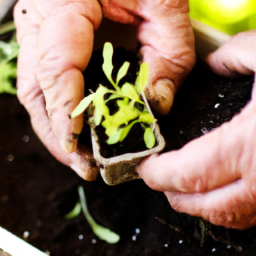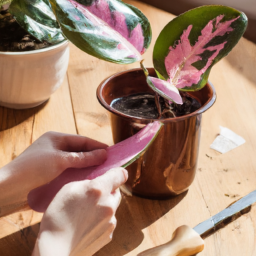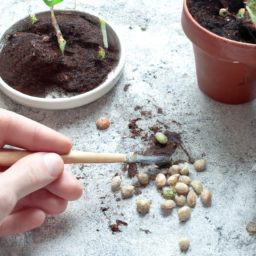
Welcome to our blog post on ‘Growing Indoor Plants from Seeds: A Beginner’s Guide’. If you’re new to the world of indoor gardening and eager to bring some greenery into your home, you’ve come to the right place. In this comprehensive guide, we will walk you through the process of starting your own indoor garden from seeds, providing you with all the necessary information and tips to help you succeed. Whether you have a green thumb or not, this beginner’s guide will equip you with the knowledge to nurture and grow beautiful plants right in the comfort of your own home. So, let’s dive in and discover the joys of growing indoor plants from seeds!
Choosing the Right Seeds for Indoor Plant Growth
When it comes to growing indoor plants from seeds, selecting the right seeds is crucial for successful growth. Whether you are a beginner or an experienced gardener, understanding the factors to consider when choosing seeds will greatly impact the health and vitality of your indoor plants. In this guide, we will walk you through the process of selecting the perfect seeds for your indoor gardening project.
1. Consider the Lighting Requirements
The first step in choosing the right seeds for indoor plant growth is to consider the lighting requirements of the plant species you are interested in. Some plants thrive in bright, direct sunlight, while others prefer partial shade or low light conditions. Understanding the lighting needs of your chosen plants will help you determine whether they are suitable for indoor cultivation.
For example, if you have a room with ample natural light, you can opt for plants that require bright sunlight, such as tomatoes or peppers. On the other hand, if your indoor space has limited access to sunlight, you may want to choose plants that can thrive in low light conditions, such as snake plants or pothos.
Remember to assess the lighting conditions in your home or office before selecting seeds, as this will greatly influence the success of your indoor gardening venture.
2. Consider the Space Availability
Another important factor to consider when choosing seeds for indoor plant growth is the available space in your home or office. Different plant species have varying growth habits and sizes, so it’s crucial to select seeds that are suitable for the space you have.
If you have limited space, you might want to consider compact plants or varieties that can be trained to grow vertically, such as dwarf varieties of tomatoes or herbs. On the other hand, if you have ample space, you can opt for larger plants like monstera or fiddle leaf figs that can make a statement as indoor focal points.
It’s also essential to consider the container size and shape when thinking about space availability. Some plants have extensive root systems and require deep pots, while others can thrive in shallow containers. Understanding the spatial requirements of your chosen plants will help you make informed decisions when selecting seeds.
3. Consider the Maintenance Level
Lastly, it’s essential to consider the maintenance level required for the plant species you are interested in. As a beginner, you may want to start with seeds that are relatively easy to grow and maintain. This will help you build confidence and experience before venturing into more challenging plants.
Some plants, like succulents or cacti, are known for their low maintenance requirements and ability to tolerate neglect. On the other hand, plants like orchids or carnivorous plants may require more specialized care and attention.
Consider your available time and commitment level when selecting seeds. If you have a busy schedule or limited time for plant care, it’s best to choose seeds that are forgiving and require minimal intervention.
Remember, the key to successful indoor plant growth lies in selecting seeds that align with your specific lighting conditions, available space, and maintenance capabilities. By considering these factors, you can embark on your indoor gardening journey with confidence and enjoy the beauty and benefits of growing plants from seeds.
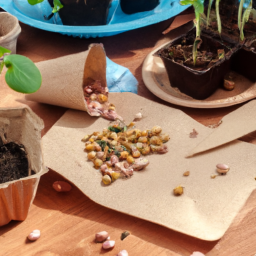
Essential Equipment and Supplies for Growing Indoor Plants from Seeds
When it comes to growing indoor plants from seeds, having the right equipment and supplies is crucial for success. Whether you are a beginner or an experienced gardener, having the necessary tools will ensure that your seeds germinate and grow into healthy plants. In this guide, we will walk you through the essential equipment and supplies you need to get started on your indoor gardening journey.
1. Seed Trays or Pots
The first step in growing indoor plants from seeds is to choose the right containers for sowing your seeds. Seed trays or pots are commonly used for this purpose. These containers provide a suitable environment for seed germination and early growth. When selecting seed trays or pots, make sure they have drainage holes to prevent waterlogging, which can lead to root rot. Additionally, opt for containers made of durable materials such as plastic or terracotta, as they retain moisture and provide insulation for the seeds.
Fill the seed trays or pots with a well-draining seed starting mix. This specialized soil mix is lighter and finer than regular garden soil, allowing for better aeration and moisture retention. It also minimizes the risk of soil-borne diseases that can harm seedlings.
Remember to label your seed trays or pots with the name and date of the seeds sown. This will help you keep track of your plants’ progress and identify different varieties.
2. Grow Lights
Indoor plants require sufficient light to grow and thrive. While natural sunlight is ideal, it may not always be available or adequate, especially during the winter months or in rooms with limited sunlight. In such cases, grow lights become essential for providing the necessary light spectrum for plant growth.
LED grow lights are the most popular choice for indoor gardening. They are energy-efficient, emit low heat, and can be adjusted to provide the optimal light intensity and spectrum for different stages of plant growth. Position the grow lights about 6-12 inches above the seedlings to ensure they receive adequate light without burning the delicate foliage.
Keep in mind that different plants have varying light requirements. Research the specific light needs of the plants you are growing to ensure they receive the right amount of light for healthy development.
3. Heating Mat
Seeds require consistent warmth to germinate successfully. A heating mat is a valuable tool that provides bottom heat to the seed trays or pots, creating an ideal germination environment. Heating mats help to speed up germination, increase seedling growth, and improve overall success rates.
Place the heating mat under the seed trays or pots, following the manufacturer’s instructions. Set the temperature to the recommended level for the seeds you are growing. Most indoor plants prefer a temperature range of 70-75°F (21-24°C) for optimal germination. Regularly monitor the temperature to ensure it remains within the desired range.
Remember to remove the heating mat once the seedlings have emerged, as excessive heat can hinder their growth and cause damage.
4. Watering Can or Spray Bottle
Proper watering is crucial for the health and growth of your indoor plants. A watering can or spray bottle is essential for providing moisture to the seeds and seedlings without causing waterlogging or damage.
When watering, ensure that the soil is evenly moist but not soaking wet. Avoid overwatering, as it can lead to root rot and other fungal diseases. Use a fine-mist spray bottle to gently mist the soil surface or a watering can with a narrow spout to water the base of the plants.
Monitor the moisture levels regularly and adjust your watering routine accordingly. As the seedlings grow, they will require more water, but be cautious not to drown them.
5. Plant Labels
Keeping track of your plants is essential, especially if you are growing multiple varieties. Plant labels are an inexpensive yet invaluable tool for identifying and organizing your indoor plants.
Use waterproof plant labels or popsicle sticks to mark each seed tray or pot with the name of the plant, variety, and sowing date. This will help you differentiate between different plants and track their progress as they grow. Additionally, labels allow you to note down any specific care instructions or observations for future reference.
Regularly check your plant labels to ensure they remain legible and in place. This will prevent confusion and make it easier to provide individualized care to each plant.
Growing indoor plants from seeds can be a rewarding and fulfilling experience. By having the essential equipment and supplies, you are setting yourself up for success. Remember to choose the right containers, provide adequate lighting and warmth, water properly, and keep track of your plants. With proper care and attention, your indoor garden will flourish and bring joy to your home.
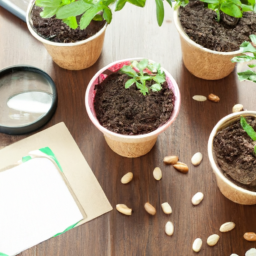
Creating the Ideal Growing Environment for Indoor Plants
When it comes to growing indoor plants from seeds, creating the ideal growing environment is crucial for their success. Indoor plants require specific conditions to thrive and reach their full potential. By providing the right combination of light, temperature, humidity, and air circulation, you can ensure that your indoor plants grow healthy and strong. In this guide, we will walk you through the steps to create the perfect growing environment for your indoor plants.
1. Light
Light is one of the most important factors for indoor plant growth. Most indoor plants require bright, indirect light to thrive. Place your plants near a window where they can receive natural sunlight, but be cautious of direct sunlight as it can scorch the leaves. If natural light is limited in your space, you can supplement it with artificial grow lights. LED grow lights are a popular choice as they provide the right spectrum of light for plant growth and are energy-efficient.
It’s crucial to understand the light requirements of the specific plants you are growing. Some plants, such as succulents and cacti, prefer bright, direct light, while others like ferns and ivy thrive in low to medium light conditions. Adjust the placement of your plants accordingly to provide them with the optimal light levels.
Keep in mind that light intensity decreases with distance, so make sure to rotate your plants regularly to ensure even growth. If you notice your plants leaning towards the light source, it’s a sign that they are not receiving enough light and need to be moved closer to the light source.
2. Temperature
Indoor plants have specific temperature requirements for optimal growth. Most common houseplants thrive in temperatures between 60°F and 75°F (15°C and 24°C). Avoid placing your plants near drafts or vents, as sudden temperature fluctuations can stress them. Also, keep them away from heaters or radiators, as the dry air can dehydrate the plants.
It’s important to note that different plants have different temperature preferences. Some tropical plants prefer warmer temperatures, while others, like succulents, can tolerate cooler conditions. Research the temperature requirements of the specific plants you are growing and adjust the temperature in your space accordingly.
During the winter months, when indoor heating can dry out the air, consider using a humidifier to increase the humidity around your plants. This will help prevent the leaves from drying out and promote healthy growth.
3. Humidity and Air Circulation
Humidity plays a vital role in indoor plant growth, especially for plants that originate from tropical or humid environments. Most houseplants prefer humidity levels between 40% and 60%. If the humidity in your home is too low, you can increase it by placing a tray filled with water near your plants or by using a room humidifier.
Air circulation is equally important for indoor plants as it helps prevent the growth of mold and mildew and ensures that carbon dioxide is evenly distributed. Avoid placing your plants in stagnant areas with poor air circulation, such as corners or closed-off rooms. Gentle air movement from a fan or open windows can help improve air circulation.
However, be cautious not to expose your plants to strong drafts, as it can cause damage to their leaves. Find a balance by providing gentle air movement without subjecting your plants to direct drafts.
In conclusion, creating the ideal growing environment for indoor plants involves providing the right combination of light, temperature, humidity, and air circulation. By understanding the specific needs of your plants and making necessary adjustments, you can ensure that your indoor plants thrive and flourish. Remember to regularly monitor and maintain the growing conditions to support healthy growth and enjoy the beauty of your indoor garden.
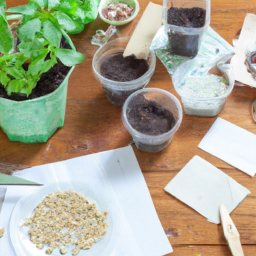
Step-by-Step Guide to Planting Seeds and Caring for Indoor Plants
Introduction
Welcome to the beginner’s guide on growing indoor plants from seeds! Whether you are a plant enthusiast or just starting your indoor gardening journey, this comprehensive guide will provide you with all the necessary steps to successfully plant and care for indoor plants from seeds. Growing plants indoors not only adds beauty to your living space but also offers numerous health benefits. So, let’s dive into the world of indoor gardening and get started with our step-by-step guide!
Step 1: Choosing the Right Seeds
The first step towards growing indoor plants from seeds is selecting the right seeds for your desired plants. Consider the lighting conditions, temperature, and humidity levels in your home. Some popular indoor plants that are relatively easy to grow from seeds include herbs like basil, mint, or oregano, as well as flowers like marigolds or pansies. Research the specific requirements of your chosen plants to ensure they can thrive indoors.
Once you have chosen your seeds, you can either buy them from a local nursery or order them online. Make sure to check the seed quality and expiration date before purchasing. It’s always a good idea to start with a few varieties to experiment and gain experience.
Prepare your indoor gardening space by setting up adequate lighting, such as fluorescent grow lights or natural sunlight, and ensuring proper ventilation for air circulation.
Step 2: Preparing the Planting Containers
Proper preparation of planting containers is essential for the successful growth of indoor plants from seeds. Choose containers with drainage holes to prevent waterlogging, as excess moisture can lead to root rot. Use clean containers to avoid any potential diseases or pests.
Fill the containers with a well-draining potting mix suitable for seed starting. Avoid using garden soil, as it may contain pests or diseases. Moisten the potting mix before planting to ensure it is evenly damp but not soaking wet.
Make small indentations or furrows in the potting mix for planting the seeds. The depth will depend on the seed size, so refer to the specific instructions on the seed packet. Place the seeds in the furrows, gently cover them with the potting mix, and lightly press down to ensure good seed-to-soil contact.
Step 3: Providing Optimal Growing Conditions
Now that the seeds are planted, it’s crucial to create the ideal growing conditions for their germination and growth. Maintain a consistent temperature range of 65-75°F (18-24°C) for most indoor plants. Place a thermometer near your plants to monitor the temperature regularly.
Light is another critical factor for indoor plant growth. Ensure your plants receive adequate light, either from natural sunlight or artificial grow lights. Most plants require 12-16 hours of light per day. If using artificial lights, position them about 6-12 inches above the plants and adjust the height as the plants grow.
Humidity is important for seed germination and overall plant health. Use a spray bottle to mist the plants and surrounding area regularly. Alternatively, you can place a tray filled with water near the plants to increase humidity levels.
Step 4: Watering and Fertilizing
Watering is a crucial aspect of indoor plant care. It’s essential to keep the soil evenly moist but not waterlogged. Check the moisture level regularly by inserting your finger about an inch into the soil. If it feels dry, it’s time to water. Use a watering can or a spray bottle with a fine mist setting to avoid disturbing the seeds or young seedlings.
When it comes to fertilizing indoor plants, it’s best to start after the seedlings have developed their first true leaves. Use a balanced liquid fertilizer diluted to half the recommended strength. Apply the fertilizer every two weeks during the growing season. Always follow the instructions on the fertilizer packaging for the correct dosage.
Remember, over-fertilization can harm the plants, so it’s better to under-fertilize than overdo it. Monitor your plants closely for any signs of nutrient deficiencies or excesses.
Step 5: Transplanting and Repotting
As your indoor plants grow, they may outgrow their initial containers. This is when you’ll need to transplant them into larger pots or containers. Look for signs such as roots coming out of the drainage holes or stunted growth, indicating the need for repotting.
Choose a new container that is one size larger and has proper drainage. Fill it with fresh potting mix and gently remove the plant from its current container. Loosen the roots, place the plant in the new container, and fill the gaps with additional potting mix. Water the plant thoroughly after repotting to help it adjust to its new environment.
Repeat the process of repotting whenever necessary, allowing your indoor plants to continue thriving and growing.
Conclusion
Congratulations! You have now completed the step-by-step guide to planting seeds and caring for indoor plants. Remember, indoor gardening requires patience, observation, and a little trial and error. Each plant has its unique needs, so always research and adapt your care accordingly. Enjoy the process of watching your seeds sprout, grow, and flourish into beautiful indoor plants that bring life and joy to your home!
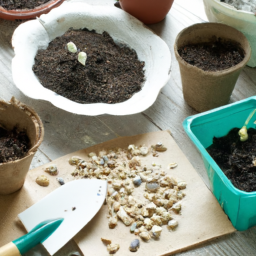
Troubleshooting Common Issues in Growing Indoor Plants from Seeds
Introduction
Growing indoor plants from seeds can be a rewarding and fulfilling experience. However, it is not without its challenges. As a beginner, you may encounter some common issues that can hinder the growth and development of your indoor plants. In this guide, we will discuss five of the most common problems that beginners face and provide practical solutions to troubleshoot them.
1. Insufficient Light
One of the most common issues faced by indoor gardeners is insufficient light for their plants. Many indoor spaces do not receive adequate natural light, especially during the winter months. Insufficient light can result in weak and leggy plants with pale leaves.
To overcome this issue, you can:
– Place your plants near a south-facing window where they can receive maximum sunlight.
– Use artificial grow lights specifically designed for indoor plants. Position the lights at an appropriate distance from the plants to provide adequate light intensity.
– Rotate your plants regularly to ensure all sides receive equal light exposure.
By addressing the issue of insufficient light, you can promote healthy growth and vibrant foliage in your indoor plants.
2. Overwatering
Overwatering is a common mistake made by beginners. It can lead to root rot, fungal diseases, and ultimately the death of your plants. Overwatered plants often have yellowing leaves, wilting, and a foul smell.
To avoid overwatering, follow these guidelines:
– Check the moisture level of the soil by inserting your finger into it. Water only when the top inch feels dry to the touch.
– Use well-draining soil that allows excess water to escape easily.
– Ensure your pots have drainage holes to prevent water from accumulating at the bottom.
By maintaining proper watering practices, you can prevent the detrimental effects of overwatering and promote healthy plant growth.
3. Lack of Humidity
Indoor environments are often drier than the natural habitat of many plants, especially those originating from tropical regions. Insufficient humidity can cause leaf browning, wilting, and stunted growth.
To increase humidity for your indoor plants, you can:
– Group your plants together to create a microclimate with higher humidity.
– Place a tray filled with water near your plants. As the water evaporates, it will increase the surrounding humidity.
– Use a humidifier to maintain a consistent level of humidity.
By providing adequate humidity, you can mimic the natural conditions required for your indoor plants to thrive.
4. Pest Infestation
Pests can wreak havoc on your indoor plants if left unchecked. Common pests include aphids, spider mites, and fungus gnats. Signs of pest infestation include yellowing leaves, sticky residue, webbing, and tiny insects on the plants.
To eliminate pests and prevent further infestation, you can:
– Inspect your plants regularly for any signs of pests.
– Remove pests manually using a soft cloth or a gentle spray of water.
– Introduce natural predators like ladybugs or predatory mites to control pest populations.
– Use organic insecticidal soaps or neem oil to treat severe infestations.
By promptly addressing pest issues, you can protect your indoor plants and ensure their healthy growth.
5. Nutrient Deficiencies
Indoor plants rely on a consistent supply of nutrients for proper growth and development. Nutrient deficiencies can manifest as yellowing leaves, stunted growth, and poor overall health.
To address nutrient deficiencies, you can:
– Choose a high-quality potting mix enriched with essential nutrients.
– Fertilize your plants regularly with a balanced indoor plant fertilizer according to the package instructions.
– Monitor the pH level of the soil and adjust if necessary to facilitate nutrient absorption.
By providing the necessary nutrients, you can ensure your indoor plants have all they need to thrive and flourish.
Conclusion
Growing indoor plants from seeds can be a delightful journey, but it is not without its challenges. By understanding and troubleshooting common issues such as insufficient light, overwatering, lack of humidity, pest infestation, and nutrient deficiencies, you can ensure the healthy growth and development of your indoor plants. Remember to observe your plants closely, make adjustments as needed, and enjoy the rewarding experience of nurturing your own indoor garden.
Highlights of this article
Growing indoor plants from seeds can be a rewarding and fulfilling experience for beginners. Not only does it allow you to witness the entire growth process, but it also gives you the freedom to choose from a wide variety of plants. To get started, it’s essential to select the right seeds for indoor cultivation, considering factors such as lighting conditions, available space, and personal preferences.
Once you have chosen your seeds, it’s time to prepare the growing environment. Adequate lighting is crucial for indoor plants, so investing in grow lights or placing them near a sunny window is essential. Additionally, providing the right amount of water, temperature, and humidity is vital for successful germination and growth.
After the seeds have sprouted, it’s important to give them proper care and attention. Regular watering, fertilizing, and monitoring for pests or diseases are key to ensuring healthy plant growth. As the plants mature, it may be necessary to repot them into larger containers to accommodate their growing roots. With patience and dedication, beginners can enjoy the beauty and benefits of indoor plants grown from seeds.
Q1: What are some easy indoor plants to grow from seeds for beginners?
A1: Some easy indoor plants to grow from seeds for beginners include herbs like basil and parsley, flowering plants like marigolds and cosmos, and leafy greens like lettuce and spinach.
Q2: What supplies do I need to grow indoor plants from seeds?
A2: To grow indoor plants from seeds, you will need seeds of your chosen plants, seed starting trays or pots, potting soil, a spray bottle for watering, grow lights or a sunny window, and a plastic cover or plastic wrap for creating a greenhouse-like environment.
Q3: When is the best time to start growing indoor plants from seeds?
A3: The best time to start growing indoor plants from seeds depends on the specific plant. Generally, it is recommended to start seeds indoors 6-8 weeks before the last frost date in your area. However, some plants may have different requirements, so it’s best to refer to the seed packet or do some research for individual plants.
Q4: How often should I water indoor plants grown from seeds?
A4: Indoor plants grown from seeds should be watered when the top inch of soil feels dry. It’s important not to overwater, as this can lead to root rot. Using a spray bottle to mist the soil surface can help maintain the right moisture level without overwatering.
Q5: Do indoor plants grown from seeds require fertilizer?
A5: Yes, indoor plants grown from seeds will benefit from regular fertilization. Once the seedlings have developed their first set of true leaves, you can start feeding them with a diluted liquid fertilizer. Follow the instructions on the fertilizer packaging for the recommended dosage and frequency.
Q6: How much light do indoor plants grown from seeds need?
A6: Indoor plants grown from seeds require bright light to thrive. If you have a sunny window, place the seedlings there, ensuring they receive at least 6-8 hours of sunlight each day. If natural light is insufficient, you can use grow lights placed a few inches above the seedlings for 12-16 hours a day.
Q7: How long does it take for indoor plants grown from seeds to germinate?
A7: The germination time for indoor plants grown from seeds varies depending on the plant species. On average, it can take anywhere from a few days to a few weeks for seeds to germinate. Refer to the seed packet or do some research on the specific plant for more accurate germination timeframes.
Q8: Can I reuse the seed starting trays for future plantings?
A8: Yes, seed starting trays can be reused for future plantings. After the seedlings have been transplanted, clean the trays thoroughly with a mixture of water and mild soap. Rinse them well and allow them to dry before using them again. This helps prevent the spread of diseases and ensures a clean environment for new seedlings.
Q9: How do I transplant indoor plants grown from seeds into larger pots?
A9: When the seedlings have grown their second set of true leaves and are strong enough to handle, they can be transplanted into larger pots. Gently loosen the soil around the seedling, lift it out with care, and place it in a prepared hole in the larger pot. Fill the gaps with potting soil, press lightly, and water thoroughly.
Q10: What are some common problems faced when growing indoor plants from seeds?
A10: Some common problems faced when growing indoor plants from seeds include damping-off (a fungal disease), inadequate light causing leggy seedlings, overwatering leading to root rot, and poor germination due to incorrect temperature or moisture levels. Proper research, care, and attention can help prevent or address these issues.
Dr. Olivia Green is a botanist with over two decades of experience in indoor plant cultivation. She holds a Ph.D. in Plant Biology and has dedicated her career to researching plant behavior in controlled environments. Dr. Green is passionate about helping plant enthusiasts master the art of indoor gardening through her extensive knowledge and practical insights.

